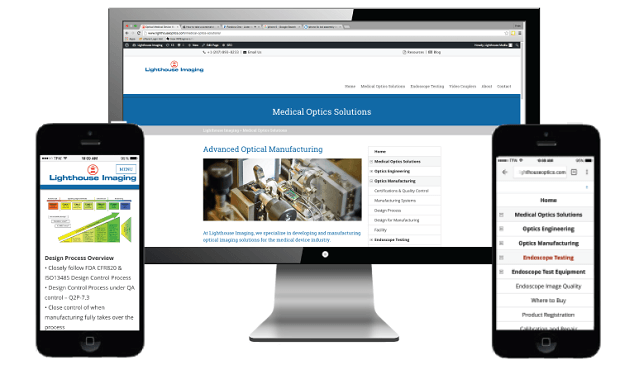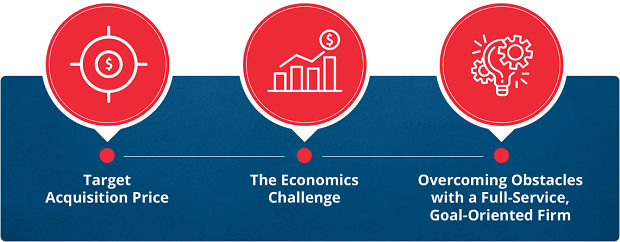Lighthouse Imaging is a contract developer and manufacturer of medical devices, with more than 35 years in operation and superior industry knowledge, specifically focused on imaging and visualization. They are a rapidly growing leader in end-to-end visualization solutions for global medical companies. Below is our recent interview with Robert Austring, CEO of Lighthouse Imaging:

Q: Could you provide our readers with a brief introduction to Lighthouse Imaging?
A: Lighthouse designs and develops cutting-edge devices, has precise manufacturing skills, and their expertise in the medical device industry is noteworthy. They have experience in developing visualizations systems for endoscopy, supporting a myriad of medical procedures ranging across arthroscopy, laparoscopy, cystoscopy, hysteroscopy, and laryngoscopy to name a few. Their experience extends into a variety of visualizations systems utilizing 2D and 3D technology and reusable and disposable systems. The company specializes in taking visualization systems from concept through commercialization. They are an FDA-registered medical manufacturing facility and provide world-class engineering services as an ISO 13485:2016 certified contract manufacturer and product development firm dedicated to the science of custom medical optics, cameras, and visualization systems.
Q: Can you tell us something more about your services?
A: From day one, Lighthouse Imaging is focused on designing products for manufacturability. There’s a heavy emphasis on the planning phase to define the product requirements and the product development strategy as defined and influenced by the regulatory strategy. There is a very focused effort on defining the product requirements, not only meeting performance specifications but just as important, the product cost. This allows us to then go into the development phase with an effective, efficient process, understanding the performance and economic objectives.
By working with Lighthouse from the onset of a project, and not just from when a product is “deemed ready,” clients can reduce the timeline for commercialization as they are developing a product for manufacturing, not just a product to meet performance criteria.
This ability to add experience to the early stage planning and strategy really positions clients to be most successful in meeting their end goals. Specifically, in the early periods of planning, it is crucial to define objectives, outline deliverables, and discuss measurable results. By thoroughly understanding the client’s end goals, Lighthouse can attack the project and produce the optimum outcomes for performance, unit cost and time to market. Because Lighthouse has extensive experience in the all areas of design and manufacturing, an industry focus, and a thorough understanding of the client’s end goals, they are able to optimally position their partners for success.
Lighthouse takes the concept from paper to a commercial device, carrying it through a regulatory compliant development process, supporting the customer throughout, and ultimately, manufacturing the product at a targeted cost. This provides the innovator with a viable intellectual property they can leverage to add value to their company. In the design, development, and manufacturing process, the communication and cohesiveness working with Lighthouse Imaging sets them apart as a preferred contract manufacturing partner.
 Recommended: An Interview With Daniel Casey, CEO Of Genii-Systems
Recommended: An Interview With Daniel Casey, CEO Of Genii-Systems
Q: You’ve created the world’s first commercial platform for 3D endoscopic devices in collaboration with OmniVision; could you tell us something more?
A: Stereoscopic, or 3D vision, technology is a true differentiating feature when incorporated into medical devices and procedures, ultimately positioning doctors and surgeons for success. When considering a partner for the integration of 3D and stereoscopic visualization into a medical device, there are three important considerations: selecting the appropriate technology, selecting a capable manufacturer, and industry expertise. These three elements combine to make the perfect manufacturing partner for global medical companies.
The technology of endoscopes is continually advancing, allowing better performance, smaller size, and more features – including stereoscopic 3D visualization. Early 3D systems were based on decades old technology that consisted of a series of expensive lenses in a long tube that was not flexible. While these systems provide a great visual image, there are many limitations that have prohibited widespread adoption. The modern design approach is a chip-on-tip system, where the image sensors are placed with the lenses at the very tip of the endoscope. The implementation of this technology was a major stepping-stone in the industry, allowing the endoscope to easily bend inside the body, providing ease of use and applicability to new and different types of surgeries.
The medical industry is historically reluctant to adopt new and unproven technology, preferring instead to leverage proven solutions. Chip-on-tip technology became a possibility because of the miniature, high-performance image sensors that were developed for use in laptops and cell phones. Successful device manufacturers are leveraging technology that exists and is proven, but hasn’t necessarily been absorbed into the market just yet. In the case of 3D visualization systems, the advancement lies in the utilization of miniature image sensors to create medical-grade devices that meet performance and cost objectives.
3D endoscopic systems have historically been quite expensive, but with the proper application of technology, manufacturers can produce devices at a great cost advantage in addition to next-generation capability.
Stereoscopic 3D systems require precise alignment of two lenses and two image sensors to mimic eyeballs. Despite an immediate ‘wow’ factor, improperly designed or manufactured stereoscopic endoscopes may cause surgeon eye strain and fatigue during prolonged usage, which ultimately limits adoption. A focus on making products as optically and mechanically perfect as possible is essential. New technology is always exciting, but the lasting positive effects lie in the subtleties. It’s imperative that the technology is capable of being implemented repeatedly and reproducibly. With the latest visualization system, the two cameras that simulate eyes and provide surgeons with true depth of field, add a completely new element to minimally invasive surgery. The technology offers a more natural feeling and assists surgeons in understanding where they are in the body. Standard 2D technology can be very disorienting, and there was an apparent need for an improved surgical method.
Solving this critical customer need is a huge stepping stone in the industry. Each time a new design begins, the project is built upon a platform developed from previous successes and they are merged. The real work comes in linking them together in a unique or custom fashion that innovators have requested. By using solid building blocks, manufacturers can come to a solution more quickly than if they were starting from scratch. Innovators bring true intellectual property or patentable technology to the process and the manufacturers assure the optimal capabilities.
Lighthouse Imaging’s chip-on-tip system in partnership with OmniVision provides a springboard platform which enables faster product development and shortened time to market. Their integrative practice and strategic thinkers have enabled this state-of-the- art invention which allows Lighthouse to help other medical device manufacturers bring this advanced technology to the market on time and at budget.
Q: What makes you a leading contract developer of medical optical systems for medical device manufacturers?
A: Lighthouse Imaging customers are medical device innovators that range from startups to some of the largest medical device companies in the world. Lighthouse is at the forefront in advancing imaging technology utilizing “Chip on Tip” (CoT). Traditional endoscopy utilizing expensive rod lens systems or fiber based flexible systems are being replaced by CoT systems which provide superior performance and a lower cost and in micro formats. The company is leading the way in integrating this cutting-edge technology for innovators who are bringing new medical strategies to the medical device industry.
In the process of development and manufacturing medical optics and digital imaging solutions, there is a fundamental, focused effort to take economics into consideration early enough in the conceptualization of a device. It’s extremely important to Lighthouse that economics are considered before pen is even put to paper, relative to designs. This is where Lighthouse Imaging excels and positions the device for success in the market.
The importance of this step cannot be stressed enough and is of great value to Lighthouse. In a particular case, a Fortune 100 company spent three and a half years developing a product, invested over $4 million in the development of that product, and came to the point where they were considering its launch, only to come to the realization that it wouldn’t meet the economic targets, and they had to shelve the product. That’s a travesty.
It’s very important that companies consider the economic side of the equation from inception, from the very beginning when considering the development of a device and Lighthouse is a partner which greatly values that process in order to avoid waste of their clients’ time and resources. With Lighthouse, the approach and relationship through the process of concept to commercialization is unique and positions the project for optimal success in the market.
 Recommended: An Interview With Jana Dybinski, VP Marketing And Culture At Rebel.com
Recommended: An Interview With Jana Dybinski, VP Marketing And Culture At Rebel.com
Q: What are your plans for the future?
A: Lighthouse Imaging pivoted their business model from a consulting or NRE firm to a hybrid contract manufacturer in 2012. Their objective is to rapidly commercialize this advancing technology to actively grow the business to be the preeminent provider of contract development and manufacturing of endoscopy visualization systems. Their mission is to be the prominent supplier of medical visualization systems, the go-to company for industry partners that have a need for optics, visualization, or imaging. Their flexible, proficient engineering staff allows them to assign the best team possible to each project and ensures clients are provided with the best resources to fit their needs. Also, whether the medical device is in the concept or late development stage, the team ensures the transition to manufacturing is smooth and efficient. They will continue to be on the cutting edge of innovation growing valued relationships with medical device companies to bring new technology to the world of endoscopy.

